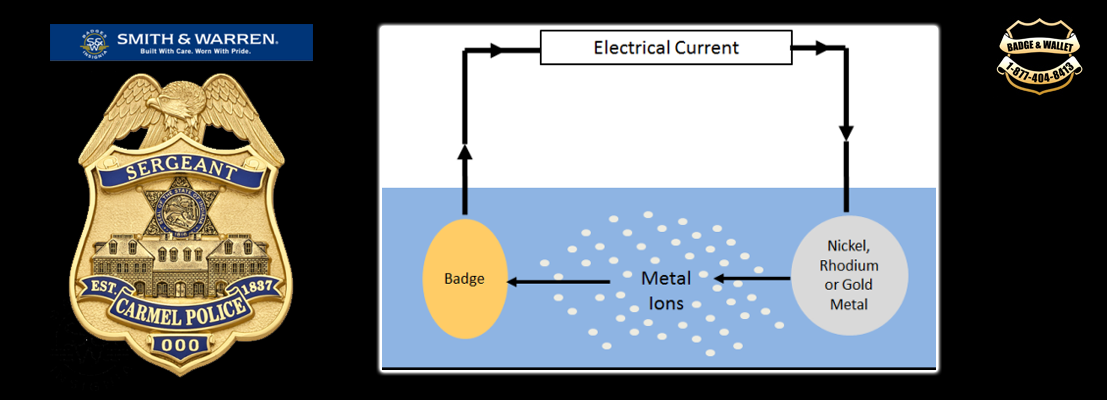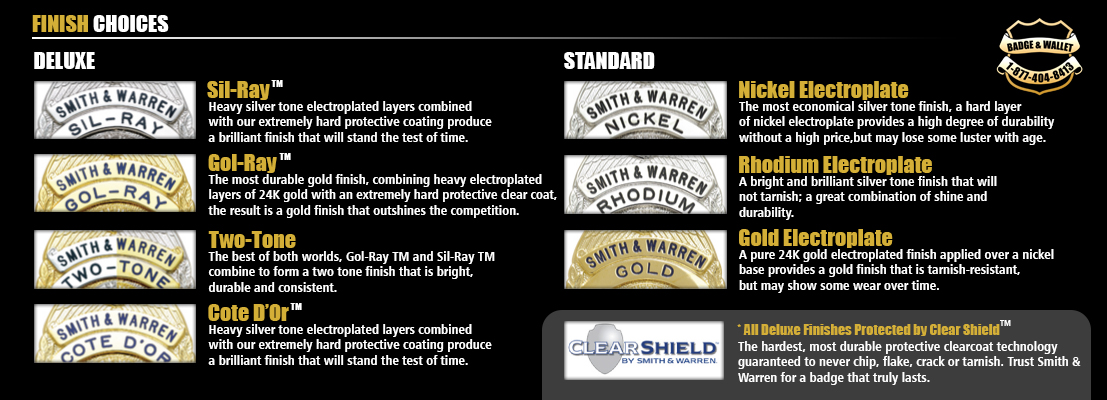
Electroplating the surface of a badge provides the most durable, brilliant, long-lasting layer of protection against tarnishing and discoloration which is why Smith & Warren employs this process in the manufacturing of all badges. This process allows the confidence to provide an industry-leading, full lifetime warranty with every Smith & Warren badge.
Why, then, do many badge manufacturers promote non-plated finishes? The answer is that electroplating is expensive and requires the use of very specialized, sophisticated equipment. Having a plating facility on site requires an extensive amount of government permits, a chemist on staff, a master plater on staff, an on-site lab, an on-site water treatment facility and a multi-million dollar capital investment in equipment. Additionally, the electroplating process adds significant cost to the product that the manufacturer must absorb. Some manufacturers do not have the financial resources to operate a modern electroplating facility and others promote non-plated badges to increase their profit margins.
Electroplating is a process that uses an electric current to deposit a layer of metal on the surface of another metal (see diagram below). While the basic chemistry of electroplating is quite simple, the actual practice is quite complex. Many years of research and testing have gone into the high tech finishes used today. Within the plated layers of your Smith and Warren badge are many proprietary additives that make the finish bright, hard and uniform.
Every badge starts as a solid brass stamping. Brass is an alloy made up primarily of copper and zinc. Both of these are base metals which means they oxidize and corrode relatively easily. The solid brass used in the badge industry has a natural golden color throughout. If you purchase a non-plated badge this is where the process ends. The brass is polished, a coating of lacquer is applied, and the badge is shipped to you.
At Smith and Warren the process is taken much further. After polishing the brass, the badge is electroplated with a protective layer of nickel. This nickel layer encapsulates the brass and protects it from corrosion (tarnishing) due to exposure to oxygen. It also provides a bright base layer to apply the precious metal coating. Some customers choose a basic nickel finish, but most choose one the 7 decorative precious metal finishes. The precious metal finishes are applied over the nickel to enhance the beauty of the badge. The precious metal finishes are all noble metals which means they are highly resistant to corrosion and oxidation.

After the decorative finish is applied, the badge is coated with a clear layer to provide maximum resistance to abrasion. This is where the Smith and Warren clear coating technology is applied. Several different methods are utilizied for clear coating your badge, including our exclusive ClearShield coating. The exact method used depends on several factors, but the methods employed by Smith and Warren result in coating that exceeds industry standards for surface hardness and resistance to abrasion.
Electroplating is an important part of the quality and beauty of the badges we sell each day. Every badge Smith & Warren manufactures comes with a full lifetime warranty without any limitations. Smith & Warren sets itself apart from all other manufacturers of badges by allowing customers FREE refinishing and repairs for life.
